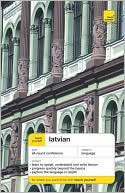 |
Teach Yourself Latvian Complete Course (Book)
Author: Terēze Svilane Bartholomew Soft Cover, 327 pages Publisher: Teach Yourself Language: English ISBN-13: 9780071478311 |
I would have much rather have had the full course, book and audio at my disposal – but when you borrow from the library, you take what you can get. Even without the audio, I must say how impressed I am with this book! I have read a fair number of beginner/intermediate language courses and grammars, spread across numerous language families, and have found few that have introduced their language so well. Readers are introduced to culture and language, rather than language alone. It proceeds at an excellent pace and is very well edited. Lastly, it ends with a list of resources for additional study, and a clear indication that there is more to learn.
This is not a grammar. If you are looking for a litany of declension and conjugation charts, you will be disappointed. Instead, concepts are introduced as necessary. The alphabet is covered in concise fashion, before introducing some pleasantries and the personal pronoun – a foundation for pointing out the use of the complement. Nouns in singular nominative are covered first, before moving to plurals. Then it moves to demonstrative pronouns, and a single verb paradigm (in only present aspect).
Only then is case introduced. Rather than focus on the cases that nicely match up with English concepts (nominative, accusative and dative and their relationship to subject, object and indirect object), the first case introduced in depth is the locative. Low numbers are added, then a second verb paradigm. From there adjectives and noun agreement are explained. Once noun modifiers have been covered, as seems appropriate, the genitive is covered.
A third present verb paradigm is offered, then a common verbal pattern called the “dative verb” allows for the dative case to be presented. And onward. In stepwise fashion, new topics are offered to the reader. Each step is combined with dialogues to help the reader grasp the concept. And though part of me craved a single chart that would call out the noun forms, or the adjective forms, or all the verbal paradigms possible, this sectioned approach allowed for syntax to be combined with word formation in a manner that fostered greater understanding.
That being said, sentence structure is never really covered as such, but since the book is largely dialogues and extended readings, one picks up this structure naturally. Key vocabulary is provided throughout, though it is not always in “dictionary” form, which frequently made it harder for me to systematize as I made notes (my standard approach to learning is to write what I read, reinforcing and causing me to slow down long enough to actually grasp the topic). At times, I felt that the the author was not descriptive or precise enough for my liking. But I could tell that the intent was to not over-burden the learner with too much, too quickly. Having already been introduced to case, heavily dative based verbal constructs, adjective agreement, and tense and voice possibilities through study of other languages, I could tell that I was wanting to go faster, and relate what I already knew in other languages to Latvian. The author steadily insisted, through information throttling, on an incremental approach for all.
Images are used sparingly, but there is still an effective amount of white space to make reading easy. Latvian words and phrases are in bold. This makes them easily differentiable from the surrounding English descriptions and instructions.
There is an answer key in the back, making the “teach yourself” aspect verifiable (greatly appreciated). A small lexicon is available in the back, but only one way, Latvian to English – one of the things I didn’t favor. Verb, noun and preposition charts are found in the back, though by the time I reached them I felt little need for them. Most helpful in the back is the listing of additional resources, which I intend to take full advantage of.
Participles and gerunds are covered briefly, mostly only as they relate to specific formulations that assisted with the dialogues. As for usage to create passive and perfect tenses – the book unashamedly declares them beyond the scope of the book. Understandable, but unfortunate. I was not impressed by the way the imperative was introduced. I almost found it deceptive, only pointing out the actual pattern once one had a firmly-seated wrong impression of its operation. As a final note, I think more time could have been spent clarifying when a plural noun phrase listed was plural-only rather than listed as plural simply for the sake of the current dialogue. Once again, my efforts at systematizing sometimes ran against the grain of the book.
I give this book ★★★★☆. While it won’t make for a great reference work in my opinion, it is an excellent tool for introducing the language and culture. It will get the reader moving in Latvian, quickly and easily – and enjoyably.




I learned using Colloquial Latvian, with the CDs, and found that worked very well. Thanks for sharing your impressions of the Teach Yourself course!